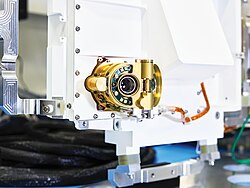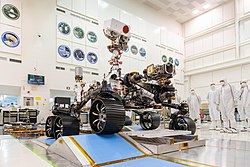PIA25590
The drill bits used by NASA’s Perseverance Mars rover are seen before being installed prior to launch. The regolith bit is on the left, followed by six bits used for drilling rock cores. On the right are two abrasion bits that are used to remove the dust-covered outer layer of a rock so that the rover can take accurate data of its composition.
A key objective for Perseverance’s mission on Mars is astrobiology, including the search for signs of ancient microbial life. The rover will characterize the planet’s geology and past climate, pave the way for human exploration of the Red Planet, and be the first mission to collect and cache Martian rock and regolith (broken rock and dust).
Subsequent NASA missions, in cooperation with ESA (European Space Agency), would send spacecraft to Mars to collect these sealed samples from the surface and return them to Earth for in-depth analysis.
The Mars 2020 Perseverance mission is part of NASA’s Moon to Mars exploration approach, which includes Artemis missions to the Moon that will help prepare for human exploration of the Red Planet.
JPL, which is managed for NASA by Caltech in Pasadena, California, built and manages operations of the Perseverance rover.Relevantní obrázky
Relevantní články
PerseverancePerseverance je vozítko („rover“), které je součástí mise Mars 2020 americké agentury NASA. Vynesení do vesmíru zajistila raketa Atlas V 541 z floridského Mysu Canaveral. Start se uskutečnil 30. července 2020, k Marsu pak kapsle s vozítkem doputovala 17. února 2021 a rover úspěšně přistál 18. února 2021 v kráteru Jezero. Sondu vyrobila kalifornská NASA Jet Propulsion Laboratory (JPL), která ji zároveň ovládá ze svého řídicího střediska. Cena vozítka je odhadnutá na 2,8 miliardy amerických dolarů, další náklady projektu pak na 1,8 miliardy dolarů. Mise měla původně trvat jeden marťanský rok, což je přibližně 687 pozemských dní, byla ovšem prodloužena a v současnosti trvá 1515 pozemských dní. .. pokračovat ve čtení










































